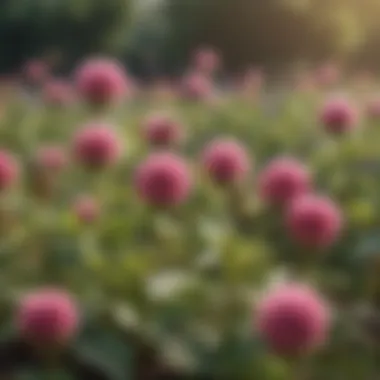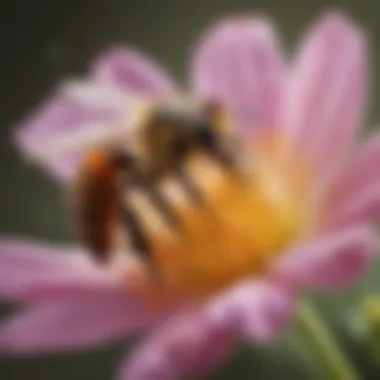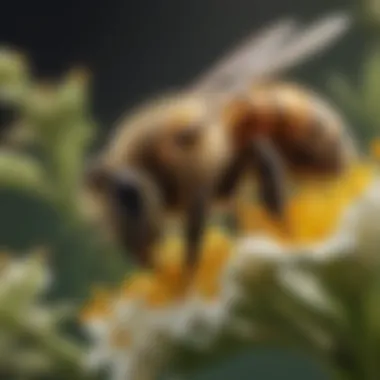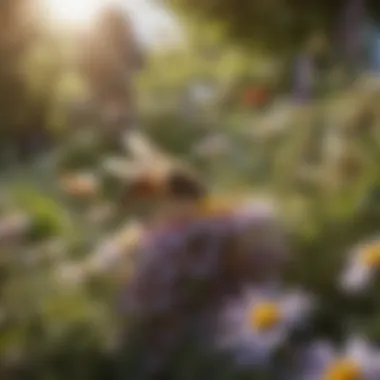The Vital Role of Bees in Flower Pollination


Intro
Bees play a crucial role in the process of pollination, which is vital for the reproductive cycle of many flowering plants. The relationship between bees and flowers is not merely one of convenience. It is a complex interplay that has evolved over millions of years. Pollination is essential for producing fruits, seeds, and the general health of ecosystems. Understanding how bees interact with different types of flowers can be beneficial for various stakeholders, including gardeners, environmentalists, and ecological enthusiasts.
This guide aims to dissect the specifics of this relationship, focusing on the flowers that attract bees and how these interactions foster biodiversity. In turn, this understanding promotes responsible gardening practices and encourages environmental stewardship. By identifying key plant species that benefit from bee pollination, we can cultivate landscapes that not only flourish but also support these critical pollinators.
Understanding Bee Behavior
To cultivate a bee-friendly environment, it's essential to understand basic bee behavior. Bees are generally drawn to flowers by their color, fragrance, and nectar availability. They exhibit preferences based on both visual and olfactory cues. For example, blue, purple, and yellow flowers tend to attract bees more than others.
Types of Bees
Different species of bees exist, each with its unique characteristics and preferences:
- Honeybees: These are social insects that live in large colonies. They are crucial for agricultural pollination.
- Bumblebees: Larger and more robust than honeybees, they thrive in cooler climates and can pollinate larger flowers due to their size.
- Solitary Bees: This category includes various species that do not form colonies. They play a significant role in local ecosystems.
Understanding the diversity of bees adds valuable context to the types of flowers that can enhance garden health and ecological balance.
Choosing Bee-Friendly Flowers
Selecting the right flowers is not only advantageous for bees but also enriches gardens. Here are several characteristics of bee-friendly plants:
- Native Species: Native flowers are adapted to local environments. They often attract local bee populations effectively. Examples include Coneflower and Black-eyed Susan.
- Nectar-Rich Flowers: Plants that offer abundant nectar are particularly attractive to bees. Sunflowers and Lavender are excellent choices.
- Flowering Periods: Choose flowers with staggered flowering times to provide continuous resources for bees throughout the growing season.
Preface to Bee Pollination
Pollination is a vital process in the reproductive cycle of flowering plants. It enables these plants to produce seeds and, consequently, sustain their populations. Without pollination, many flowering plants would struggle to reproduce, leading to declines in plant diversity. This section explores the significant role of bees in this essential process and highlights why understanding their actions is crucial for gardeners, environmentalists, and anyone interested in promoting biodiversity.
The Importance of Pollination
Pollination has implications far beyond just plant reproduction. In agricultural systems, about 75% of the global food crops depend on animal pollination, with bees making up a considerable portion of this work. They enhance not only food production but also contribute to ecosystem stability. The transfer of pollen from one flower to another leads to genetic diversity, which strengthens plant resilience to pests and diseases. Additionally, this process supports a food web that sustains various animal species, emphasizing the interconnectedness of life on Earth.
By nurturing bee populations, humans indirectly support their own food security and environmental health. The wide range of fruits, vegetables, and nuts that humans enjoy are largely due to the tireless work of bees, making their role in agriculture undeniable.
Bees: The Primary Pollinators
Among various pollinators, bees are the most effective. This effectiveness stems from several factors, including their physical adaptations and behaviors. Bees possess furry bodies that trap pollen grains, ensuring efficient pollen transfer as they move from flower to flower. Their foraging behavior is also structured; they commonly visit flowers in a pattern that maximizes pollen collection and transfer.
Honeybees, for instance, are social insects that work in harmony within colonies, sharing information about flowering resources. Solitary bees, while not as numerous, also play an invaluable role in specific ecosystems. They often visit certain flowers that honeybees may overlook, contributing to a diverse range of pollination.
“In a world where many species face decline, the role of bees in maintaining healthy ecosystems cannot be overstated.”
Understanding the unique roles of different bee species in pollination can help inform conservation efforts. By recognizing how bees pollinate, we can create environments that support their populations and, in turn, enhance plant reproduction and biodiversity.
Characteristics of Flowers Favored by Bees
Understanding the characteristics of flowers that bees favor is crucial for anyone interested in supporting pollinators. This knowledge impacts not just garden design but also the broader ecosystem. Flowers that resonate well with bees often exhibit particular traits. Awareness of these traits enhances the selection of plants, leading to a more inviting environment for these essential pollinators.
Color Preferences
Bees have distinct color preferences when it comes to flowers. They are particularly attracted to blue, purple, and yellow hues. This attraction is due to the fact that bees can see ultraviolet light, which is invisible to humans. Many flowers have patterns, called nectar guides, that are visible in ultraviolet light. These patterns help guide bees to the nectar source.
A variety of flowers like lavender or bluebells often draw bees in because of these appealing colors. In contrast, red flowers are generally less attractive to bees. This characteristic can be critical for gardeners seeking to cultivate a bee-friendly space. By planting flowers in the blue, purple, and yellow spectrums, one can significantly increase the chances of attracting bees.
Fragrance and Nectar Availability


Fragrance plays a significant role in attracting bees. Many flowers emit a sweet fragrance, signaling their availability of nectar. This scent can guide bees from a distance, allowing them to locate food sources efficiently. Flowers such as honeysuckle and jasmine are known for their strong aromas, which draw in not just bees but a variety of pollinators.
Moreover, the availability of nectar is paramount. Flowers with abundant nectar will typically attract more bees. These plants must also offer nectar throughout the growing season. A continuous supply ensures that bees can feed and thrive over time. It can be helpful to choose a variety of plants that bloom at different times, ensuring a steady supply of nectar throughout the seasons.
Flower Shape and Structure
The shape and structure of flowers can significantly affect their attractiveness to bees. Some bees are more suited to specific flower shapes. For example, tubular flowers are often favored by long-tongued bees, while flat-headed flowers are preferred by short-tongued species.
The accessibility of pollen and nectar is also a factor. Flowers that allow easy access to these resources will likely be more attractive to bees. Plants like daisies, which have open structures where bees can easily land, are often popular choices. Consider the diversity of flower types in your garden to accommodate various bee species and their unique preferences.
A thoughtful approach to planting flowers is essential for optimizing bee pollination. Selecting plants based on color, fragrance, and structure can create a thriving environment for bees, promoting both pollination and the overall health of the ecosystem.
Types of Flowers that Attract Bees
Understanding the types of flowers that attract bees is essential for anyone interested in improving their garden's biodiversity. The relationship between flowering plants and bees is not merely one of mutual benefit. Bees play a pivotal role in the reproductive cycle of many plants. Without bee pollination, these plants may struggle to reproduce. Therefore, selecting the right flowers becomes crucial. Different flowers have their unique attributes that make them more attractive to these pollinators.
Wildflowers
Common Types of Wildflowers
Wildflowers are often favored by bees due to their easy accessibility and abundant nectar. Common types include daisies, buttercups, and goldenrod. These flowers tend to have vibrant colors and an open structure, allowing bees to easily land and collect nectar. Their rugged nature makes them resilient and suitable for various environments. Such plants provide natural habitats for bees and support local ecosystems.
These wildflowers bloom at different times of the year, which ensures a steady food supply for bees throughout the seasons. Their adaptability means they require less maintenance than cultivated flowers, making them an excellent choice for gardeners.
Seasonal Variability in Availability
The availability of wildflowers varies throughout the seasons. In spring, flowers like bluebells and cowslips emerge, while summer brings wild roses and snapdragons. This seasonal variability is significant for the ecosystem as it ensures that bees have food sources at different times of the year.
Choosing flowers that bloom at various times fosters a continuous supply of nectar and pollen. This is especially beneficial for sustaining bee populations. Planters should consider a mix of early and late blooming species to maximize the chances of attracting bees for longer durations.
Garden Flowers
Perennials and Annuals
When we talk about garden flowers, both perennials and annuals draw in bees. Perennials like black-eyed Susans return year after year, providing consistent resources for pollinators. Annuals such as zinnias and marigolds complete their life cycle in one year. They are equally attractive to bees, especially when planted in groupings.
The key advantage of using perennials is their ability to establish strong root systems, aiding soil health. Annuals, on the other hand, offer vibrant, plentiful blooms in a short time. Thus, using both can create a dynamic garden that continuously attracts bees.
Native versus Non-Native Plants
Native plants are often best for attracting local bee species. They have co-evolved with bees, creating mutual relationships suited to local ecosystems. On the contrary, non-native plants can sometimes outcompete local species or fail to provide adequate resources for local pollinators.
Examples of native plants include echinacea and purple coneflower, which are easily recognized by their unique structures. They attract a wide variety of bees and contribute positively to the local environment. Choosing native over non-native species can significantly bolster local biodiversity and ensure the survival of bee populations.
Fruit-Bearing Plants
Common Fruits Pollinated by Bees
Fruit-bearing plants commonly pollinated by bees include blueberries, raspberries, and apples. These crops rely heavily on attractive flowers to facilitate bee visitation. The pollination process enhances fruit quality and yield, leading to healthier produce.
Bees are especially drawn to these flowers due to their vibrant colors and rich nectar production. This interaction not only supports bee health but also results in better crop returns for agriculturalists.
Best Practices for Attracting Bees to Orchards
To maximize bee visits, it is essential to establish a welcoming environment in orchards. This can include planting pollinator-friendly flowers around the orchard area and minimizing pesticide use. These practices encourage bee populations to thrive in the vicinity of fruit-bearing plants.


Maintaining diversity within the landscape is also important. This can involve inter-planting various flowering plants alongside fruit trees. Such steps will ensure that bees have access to food sources throughout the entire blooming period. Additionally, providing water sources can further attract bees, making an orchard a more inviting habitat.
Specific Flowers Known for Bee Attraction
Understanding the specific flowers that attract bees is crucial for promoting pollinator health and enhancing biodiversity. Bees play a vital role in the pollination of flowering plants, and certain flower species are particularly benefical in attracting these pollinators. By cultivating these flowers, we not only support bee populations but also improve the health of our gardens and ecosystems.
Lavender
Lavender is a perennial flowering plant that is well-known for its fragrant purple blooms. It is a significant bee magnet due to its ample nectar supply. Bees are especially drawn to lavender because of its strong scent, which can be detected from a distance.
Planting lavender creates an inviting habitat that supports honeybees and native bee species alike. Additionally, lavender is drought-resistant and can flourish in various soil types, making it a practical choice for gardeners.
Advantages of Growing Lavender:
- Attracts various bee species: Honeybees and bumblebees are particularly fond of the nectar from lavender.
- Reduces garden maintenance: Its resilience to drought means less watering is required.
- Multipurpose use: Beyond its beauty, lavender can be used in cooking and aromatherapy, providing additional benefits to gardeners.
Sunflowers
Sunflowers are one of the most recognizable flowers, characterized by their tall stalks and large, vibrant yellow blooms. These flowers are highly attractive to bees due to their size and the plentiful pollen they produce. Sunflowers provide a rich food source for bees during the blooming season, especially when planted in large groups that create a stunning visual impact.
Planting sunflowers can significantly boost local bee populations, and they thrive in sunny locations, making them easy to include in most gardens. They can also serve as a host for other beneficial insects, adding more ecological value.
Benefits of Sunflowers in the Garden:
- High pollen production: This encourages bees to visit multiple times.
- Supports biodiversity: Their presence attracts not just bees but other pollinators as well.
- Beautiful aesthetics: They add a cheerful color scheme to garden spaces, lifting the visual appeal.
Bee Balm
Bee Balm, also known as Monarda, is revered for its tubular flowers that come in various colors like red, purple, and pink. This flower is named for its importance in attracting bees, offering both nectar and pollen. The unique shape of its flowers makes it particularly appealing to bumblebees, who can easily access the resources it offers.
Key Features of Bee Balm:
- A diverse range of blooms: This plant provides color from late spring until frost, offering food for bees over an extended period.
- Medicinal properties: Beyond its attraction to pollinators, bee balm has traditional uses in herbal medicine, adding value to its presence.
- Companion planting: Bee balm can also help deter pests in the garden, making it beneficial for other plants.
Clover
Clover is a common sight in many grasslands and gardens, known for its small, round flower heads that can be white, pink, or purple. It is particularly appealing to bees because of its production of both nectar and pollen. Clover thrives in various conditions, making it an easy addition to any yard and helping to revitalize poor soil.
Attributes of Clover That Benefit Bees:
- Continuous bloom: Clover flowers throughout the growing season, providing a reliable food source for bees.
- Soil enhancement: As a legume, clover helps fix nitrogen in the soil, improving its nutrients for other plants.
- Low maintenance: It is an easy plant to manage, requiring minimal care once established.
By incorporating these specific flowers into gardening practices, we create environments that support bee populations and the broader ecosystems they sustain. Choosing the right plants is essential for encouraging pollinator activity and promoting biodiversity in our gardens.
The Ecological Impact of Bees and Flowers
The relationship between bees and flowers is crucial, not only for the survival of these insects and plants but also for the broader ecosystem. This section explores the significance of this interaction and its benefits to the environment. Understanding these connections is essential for anyone interested in environmental stewardship and biodiversity conservation.
Biodiversity Enhancement
Bees play a pivotal role in promoting biodiversity. By pollinating various flowering plants, they help maintain diverse ecosystems. Numerous studies indicate that a high level of plant diversity can lead to more resilient ecosystems, which are essential in combating climate change and habitat loss. When bees visit flowers, they facilitate genetic mixing, which results in healthier plant populations. The more diverse the plant life in an area, the more habitats are created for other organisms, fostering a rich web of life.
It's important to plant a variety of flowers that bloom at different times of the year. This ensures bees have access to food sources throughout their active seasons. Some plants that are beneficial for enhancing biodiversity include milkweed and coneflower. These plants not only attract bees but also support other beneficial insects.
Soil Health Improvement


The role of bees in pollination also extends to soil health. Pollinated plants produce seeds and fruits, which contribute organic material back into the soil when decomposed. Healthy soil is vital for growing food and supports a range of organisms that contribute to nutrient cycling. The presence of bees leads to a greater variety of plants in an ecosystem, which in turn promotes a healthier soil structure.
Furthermore, better soil health means more capacity for water retention and carbon sequestration. This is particularly important in areas susceptible to erosion or drought. Having a variety of plants can improve soil microbiome diversity, which is essential for nutrient availability.
Food Production and Security
Bees are integral to food production. They directly affect the yields of many crops, including fruits, vegetables, and nuts. According to the Food and Agriculture Organization (FAO), about 75% of the world’s food crops depend on pollination. Without bees, the availability of various food items would decline significantly.
As the global population grows, maintaining food security becomes increasingly important. Promoting bee-friendly practices in agriculture can enhance crop productivity. Simple measures like ensuring that there are flowering plants nearby can make a remarkable difference to local bee populations.
In regions where bees thrive, farmers often note higher yields and increased quality of produce.
To sum up, the ecological impact of bees and flowers is profound. Their relationship is foundational to fostering biodiversity, enhancing soil health, and securing food production for future generations. Recognizing this can lead to more informed gardening and agricultural practices, helping to create a sustainable environment for all.
Encouraging Bee-Friendly Gardening Practices
Creating a supportive environment for bees in gardens is crucial. Bee-friendly gardening practices not only help these insects thrive, but they also enhance biodiversity and contribute to ecosystem stability. Gardens play a pivotal role in providing food resources and habitats for bees. A few focused actions can yield significant benefits for these pollinators and the overall health of our environment.
Choosing the Right Plants
A primary aspect of encouraging bee-friendly gardening is selecting the right plants. It’s important to choose native flowering plants, as they are well-adapted to local climate and soil conditions. Native species often have evolved alongside regional bee populations and provide the most suitable resources.
- Opt for a diversity of flowers: Different types and colors of flowers attract various bee species. Incorporate plants such as lavender and bee balm for long-lasting blooms.
- Select plants that flower in succession: This ensures a continuous food supply throughout the growing season. For example, choose early bloomers like crocus and later season plants such as asters.
- Consider bloom shape: Some bees prefer specific flower shapes. For instance, tubular flowers attract hummingbirds while flat flowers are easy for many bee species to access.
Creating a Pollinator Habitat
Creating a suitable habitat is essential for honeybees and wild bees. The habitat should include food sources, nesting sites, and water sources. This diversity fosters a healthy bee population.
- Leave patches of bare soil: Ground-nesting bees require undisturbed soil for burrowing. Allowing areas of bare soil in the garden supports these species.
- Install bee hotels: These structures provide nesting opportunities for solitary bees, which often do not live in hives. Place them in sunny locations, protected from rain.
- Incorporate water features: Bees need water for drinking and cooling their hives. Even a shallow dish with stones can serve as a water source.
Avoiding Harmful Pesticides
The use of pesticides presents a significant threat to bee populations. Many common pesticides are toxic to these beneficial insects. Therefore, avoiding harmful chemicals is vital.
- Research organic gardening practices: Utilize natural pest control methods, such as introducing beneficial insects or using insecticidal soap. These alternatives can keep pest populations in check without harming bees.
- Apply pesticides responsibly: If necessary, choose bee-friendly options and apply them in the evening when bees are less active. Always follow label instructions for safety.
- Educate others: Share knowledge about the importance of reducing pesticide use within your community. Advocacy can lead to wider changes in gardening practices.
Adopting bee-friendly gardening practices not only supports bee populations but also enriches garden ecosystems, thereby promoting a healthier environment overall.
Epilogue
The topic of bee pollination and its relation to flowers is a critical area of study that has significant implications for both ecosystem health and human practices. Understanding how bees contribute to the fertilization of flowering plants illuminates the profound connection between these two entities. The enhancement of biodiversity through effective bee pollination is essential, especially in a world facing increasing environmental challenges.
Key elements in this discussion include the unique characteristics of flowers that attract bees, such as color, fragrance, and nectar availability. Knowing which specific flowers cater to bee preferences allows gardeners and landowners to make informed choices in their planting decisions. This can cultivate environments that not only support bee populations but also enhance the overall ecological landscape.
Moreover, the ecological benefits of promoting such relationships are far-reaching. Effective pollination contributes to soil health and sustains food production, which is vital for securing food needs globally. As the adverse effects of pesticide use and habitat loss continue to threaten bee populations, adopting bee-friendly practices becomes an essential consideration for anyone invested in environmental stewardship.
"Protecting bees and their habitats is not just a matter of preference; it's an ecological necessity that touches upon the broader themes of sustainability and biodiversity."
In summary, the significance of bees in flower pollination cannot be overstated. The knowledge gleaned from studying this relationship empowers gardeners and environmental advocates to take meaningful action in preserving both bee populations and the diverse plant life they pollinate.
Summary of Key Points
The intricate relationship between bees and flowering plants is marked by several key points:
- Bees serve as primary pollinators that facilitate the reproduction of numerous flowering species.
- Specific flower characteristics—such as color, shape, and scent—affect their ability to attract bees.
- A diverse selection of plants can create a more hospitable environment for various bee species.
- Supporting pollinators has implications for food security and biodiversity.
Future Directions for Research
As we consider future directions for research, several areas warrant attention:
- Investigate the impact of climate change on flower-bee interactions. Changes in temperature and weather patterns could influence flower blooming times and nectar production.
- Explore innovative strategies to reduce pesticide impacts on bee populations while ensuring agricultural efficacy. Understanding the balance between crop protection and pollinator safety is vital.
- Examine the role of urban gardening in supporting bee populations. As cities expand, understanding how green spaces can facilitate biodiversity becomes crucial.
- Study emerging threats to bee health, such as disease and habitat loss, and explore holistic approaches to their conservation.
Continued research is necessary to adapt our practices and policies to support both bee populations and the broader ecosystem in which they thrive.







